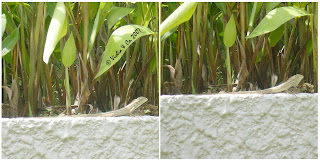Anyway it was an eye-opener! Yups, even though I have been to quite a number of hunting trips before, the dogs in SBWR are quite different from those you find in Pasir Ris. For your information, the Pasirians are darn determined hunters. Because Sj's project is on the diet of these water snakes, we only have to catch those who have fed themselves or who are feeding.
Anyway, I saw 3 feeding. And had observed 2 of them doing so myself. The first one was a big snake (relatively to those in SBWR) but the fish it was trying to swallow was twice its width! Still it managed to gobble up the whole fish, impressive! The thing was, it immediately went into the water upon swallowing the fish, as if knowing I was waiting to catch it. Darn, me and Cp chased after it until a distance before it decided to come on (rock)shore again.
The second snake had a much harder time trying to swallow the fish. Its prey was more than twice the width of its body and the poor little Pasirian's gape was just not wide enough , or so it seemed. But it persevered and finally managed to swallow 1/3 of the dead fish. It was so determined to swallow its prey that it tried means and ways to force it down its mouth. Firstly, the snake twist and turn its head to get the fish into its mouth. Then it swarm out into the water and tried to swallowed it (which I could not understand why). We gave chase again and continued our observation when it swarm to another point along the banks. One method used by doggy was it elevated its head and pointed it downwards, pressing the food (it was biting on) against the ground. I never knew if it managed to swallow at the end because it swarm away when another big snake came over to disturb it. Duh! Below is a picture of a doggy from SBWR. Apparently, it gave up on the fish after 30 mintues, unlike the Pasirians.

It is really interesting to note that the foraging behaviour of these snakes differ in both sites, albeit of the same species. The ones in SBWR seem to feed (mostly) on smaller fishes and adopted more of a 'sit-and-wait' hunting technique. On the other hand, the Pasirians have been observed to go around hunting for bigger preys. Still, there are those who just lay in wait in the water for small fishes to swim by. I saw one doing just that. Although it struck at lightning speed, the fish managed to elude its predator. Better luck next time doggy!
Me and Cp came to a conclusion that these guys do not always follow the optimal foraging theory. Being an optimal forager means that the snake will focus on consuming the most energy while expending the least amount of energy. But in the field, we can see that not all of them adopt this theory. Instead, they are observed to exercise the most efficient foraging strategies, in accordance to their physiology and the environment.
-------------------------------------------------------------
I was at Blk 7 (NIE) busstop in the afternoon (at about 11:45 a.m.) when I spotted 2 Changeable lizards (Calotes versicolor)!

Notice that lizzy1's throat was puffed up. But I don't why eh? Maybe it was trying to scare me away, ha.


Lizzy2! See the 2 white bands on the dorsal side of lizzy.
These exotic creatures are really adaptable, having intergrated well to life on this little island. They are so common that one could see them almost everywhere. Just on Monday, I saw 2 in school. In fact I have seen them around NTU on many occasions.




No comments:
Post a Comment